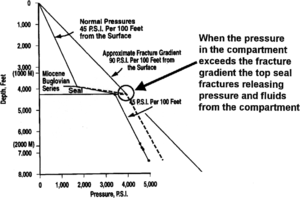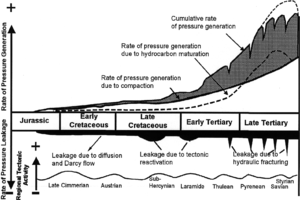Pressure compartment seals
| It has been suggested that this article be merged with [[::Pressure compartments|Pressure compartments]]. (Discuss) |
| Exploring for Oil and Gas Traps | |

| |
| Series | Treatise in Petroleum Geology |
|---|---|
| Part | Critical elements of the petroleum system |
| Chapter | Formation fluid pressure and its application |
| Author | Edward A. Beaumont, Forrest Fiedler |
| Link | Web page |
| Store | AAPG Store |
Pressure vs. capillary seals
A seal can be either a pressure seal, a capillary seal, or both. They are defined as follows:
- Pressure seals define pressure compartment boundaries. They can also act as capillary seals and define trap boundaries. Pressure seals impede the flow of hydrocarbons and water. They form where pore throats are effectively closed and absolute permeability is near zero.
- Capillary seals define trap boundaries. Capillary seals impede the flow of hydrocarbons. They form where capillary pressure across the pore throats of a rock is greater or equal to the buoyancy pressure from a hydrocarbon column. Water can move through an interconnected pore system in a capillary seal.
Pressure compartment top-seal genesis
Commonly, the top seal is at depths where formation temperature is about temperature::200°F (temperature::90°C). Evidently, this temperature influences the development of authigenic materials. Quite possibly the zone of mineralization stays near the temperature::200°F isotherm, migrating as the basin subsides or rebounds. Once a seal forms, however, fluid migration through the seal is restricted, so it is more difficult for a seal to dissolve than to form. If so, there may be fossil seals that reflect previous isotherms in the basin.
Side and bottom seals
Bottom seals of regional compartments are usually well-defined lithostratigraphic units. Side or lateral seals can be a lateral convergence of the top and bottom seals; side seals can also be thin, mineralized zones paralleling vertical faults.
Leaky seals
Pressure compartment seals do not usually seal perfectly. If the pressure generation rate within the compartment is greater than the rate of leakage, then pressure will build up in the compartment.
Episodic leakage of hydrocarbons

Regional pressure compartment pressures build as a result of |hydrocarbon generation and other mechanisms. Intermittent release of hydrocarbons and other fluids occurs when hydrostatic pressure exceeds the fracture gradient of the top seal. Hydrocarbons released from regional pressure compartments charge formations overlying the top seal of the compartment. Subsequent bleed-down of pressure allows temporary rehealing of the fractures. This cycle undoubtedly repeats many times. (David Powley, personal communication).
The pressure-depth plot in Figure 1 is from Ernie Dome, Central Transylvania basin, Romania. It shows how pressure and fluids are released from a compartment when pressure in the compartment reaches the top-seal fracture pressure.
Example of episodic leakage

Figure 2 is a plot of rate of pressure generation vs. rate of pressure leakage for a pressure compartment in the Central North Sea graben. It correlates tectonic activity with pressure leakage caused by fault reactivation and hydraulic fracturing of the top seal.
See also
- Pressure compartments
- Regional pressure compartments
- Subregional and local pressure compartments
- Applying pressure compartment concepts to exploration
References
- ↑ Leonard, R. C., 1993, Distribution of sub-surface pressure in the Norwegian Central Graben and applications for exploration, in J. R. Parker, ed., Petroleum Geology of Northwest Europe: Proceedings of the Geological Society's 4th conference, London, p. 1305–1313.
- ↑ Gaarenstroom, L., R. A. J. Tromp, M. C. de Jong, and A. M. Brandenburg, 1993, Overpressures in the Central North Sea: implications for trap integrity and drilling safety, in J. R. Parker, ed., Petroleum Geology of Northwest Europe: Proceedings of the Geological Society's 4th conference, London, p. 1305–1313.